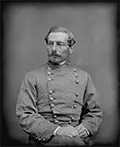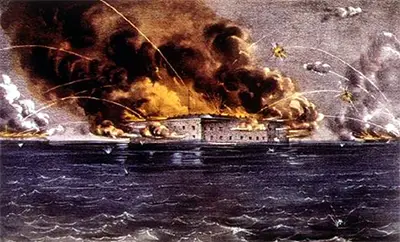Confederate General P.G.T. Beauregard
P.G.T. Beauregard was a Confederate general during the American Civil War. He is most well-known as the commander who ordered the first shots of the war. 
He was born on May 28, 1818, in St. Bernard Parish, La. He attended schools in New Orleans and New York City and then enrolled at the U.S. Military Academy in 1834. Graduating four years later with a commission as second lieutenant on engineers, he served on coastal survey and defense duty for the next eight years, in Florida, Maryland, Rhode Island, and his home state of Louisiana. During this time, he married Marie Laure Villêre; they had three children. Beauregard fought in the Mexican-American War, on the staff of Gen. Winfield Scott during the latter's capture of Mexico City. After that war ended, Beauregard returned to his home state and commanded the coastal defenses there. In 1850, his wife, Marie, died giving birth to their child. Beauregard later married Caroline Deslonde. 
West Point appointed him superintendent January 1861, but his stay there and in the U.S. Army was brief. He resigned his commission in February and joined the Confederate army, with the rank of brigadier general. His first assignment was as commander of the forces surrounding Fort Sumter, in Charleston harbor. It was Beauregard who gave the order to fire the first shots on the Union troops inside the fort there, beginning the Civil War. Having been sent north to defend Manassas, Va., against an expected Union invasion, he was on the field at the First Battle of Bull Run. The overall commander of Confederate forces was Gen. Joseph Johnston, and he and Beauregard frequently disagreed on strategy. In fact, Beauregard disagreed with his commander-in-chief, Confederate President Jefferson Davis, as well. Davis, who had just promoted Beauregard to the rank of general, agreed to send him west, to be second-in-command to Gen. Albert Sidney Johnston. Beauregard assumed command of the troops at the Battle of Shiloh, after Johnston was killed during the first day of fighting. Beauregard's delay in seizing the initiative resulted in an eventual Union victory at Shiloh. He led his troops to Corinth, Miss., and then lost that vital rail junction as well, retreating to Tupelo in the face of a large Union force poised to attack Corinth. In June 1862, Beauregard, suffering from ill health, left the front lines to recover. He did not have permission to do this, and Davis relieved him of his command. Well again, he returned in August and was sent to command the coastal defenses in Georgia and South Carolina. He oversaw spirit defenses of Charleston by Union forces in early 1863, including one featuring ironclad ships, and a heavy bombardment on Fort Sumter later that year. He used his West Point training to implement some innovative engineering-driving defense systems, such as employing submarines and mines. Moved north again in April 1864, Beauregard headed up the Department of North Carolina and Southern Virginia and was initially in charge of the Confederate troops defending the vital railroad junction of Petersburg. He was instrumental in withstanding a withering attack by a much larger Union force in June, providing time for reinforcements to arrive. Once Robert E. Lee and the Army of Northern Virginia arrived and the Union army under Ulysses S. Grant settled in for the siege that eventually resulted in the capture of Petersburg, Beauregard went west again, in an attempt to check the advance of William T. Sherman through Georgia and then South Carolina and North Carolina. Beauregard's last Civil War assignment was as second-in-command to Joseph Johnston, in February 1865. The two surrendered in April, after Lee surrendered to Grant at Appomattox. Beauregard went home again after the war, serving as president of the New Orleans, Jackson, and Great Northern Railroad and the New Orleans and Carrollton streetcar line. He also served as commissioner of the Louisiana state lottery. He served as state adjutant general from 1879 to 1888. During Reconstruction, he took part in an attempt to launch a third political party. (It was not his first foray into politics: He had run unsuccessfully for mayor of New Orleans in 1858.) In his later years, he published his memoirs. He died in New Orleans on Feb. 20, 1893; he was 74. |
|
Social Studies for Kids
copyright 2002–2024
David White




